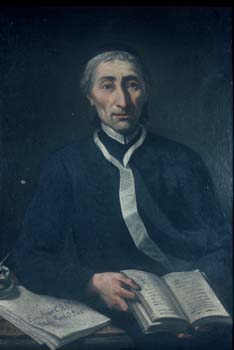Eusebius Amort facts for kids
Eusebius Amort (born November 15, 1692 – died February 5, 1775) was a very smart German Roman Catholic thinker. He was known as a theologian, which means he studied and wrote about religious ideas and beliefs. He lived a long time ago, in the 1700s, and was famous for his many writings and for helping to bring new ideas to Bavaria, a region in Germany.
Contents
His Early Life and Studies
Eusebius Amort was born in a small place called Bibermuhle, near Tolz in southern Germany. He went to school in Munich. When he was still quite young, he joined a group of religious men called the Canons Regular at Polling. Soon after he became a priest in 1717, he started teaching about religious ideas (theology) and how people think (philosophy) at Polling.
Starting a New Society
In 1720, Amort and two other religious fathers, Gelasius Hieber and Agnellus Kandler, had an idea. They wanted to start a learned society called the Parnassus Boicus. This group would share interesting information about arts and sciences. Their first plans didn't work out, but in 1722, they published the first issue of their journal, also called Parnassus Boicus. It shared many new ideas.
Amort also started an academy at Polling. This academy became so good that it later inspired the famous Academy of Sciences in Munich.
Time in Rome and Return Home
In 1733, Amort traveled to Rome, Italy. He worked there as a theologian for an important church leader named Cardinal Niccolo Maria Lercari. After two years, in 1735, he returned to Polling. He spent the rest of his life working to bring new learning and knowledge to Bavaria. He passed away in Polling in 1775.
What Eusebius Amort Wrote
Eusebius Amort was known as one of the most learned people of his time. He wrote many, many books and papers on all sorts of topics! He wrote about everything from poetry to astronomy, and from religious beliefs to spiritual experiences.
Some of his most well-known works include:
- A big book about theology, called Theologia eclectica, moralis et scholastica. It was published in 1752.
- A book that defended Catholic beliefs, titled Demonstratio critica religionis Catholicae (published in 1751).
- A book about indulgences (a Catholic practice), called De Origine, Progressu, Valore, et Fructu Indulgentiorum (published in 1735).
- A book about planets and how they move, an astronomy book called Nova philosophiae planetarum et artis criticae systemata (published in 1723).
He also wrote a book about visions and spiritual experiences, called De Revelationibus et Visionibus, etc. (published in 1744). In this book, he disagreed with some ideas from another book written by a Spanish nun. This caused some discussions with her supporters.


